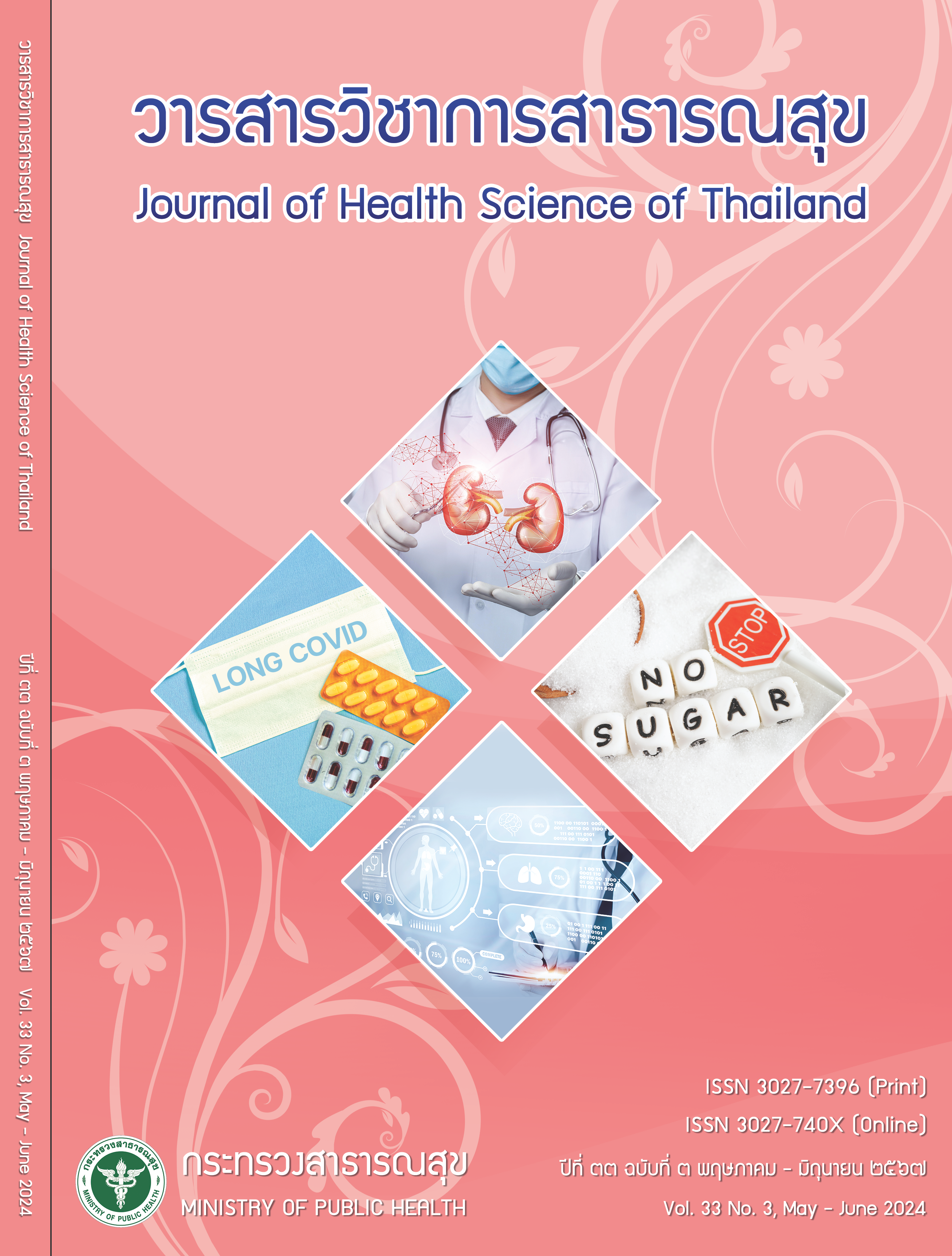Factors Associated the Success of Uretero-Renoscopic Lithotripsy in One Day Surgery
Keywords:
uretero-renoscopic lithotripsy, one-day surgery, ureteric calculiAbstract
Urolithiasis is a high prevalent disease that impact to the health resources in Thailand. One-day uretero-renoscopic lithotripsy is one of the surgical procedures that can relieve this problem. The purposes of this study were to explore the outcomes and identify factors associated with the success of one-day uretero-renoscopic lithotripsy in ureteric calculi treatment. It was conducted as a prospective cohort study in 65 patients with ureteric calculi treated with uretero-renoscopic lithotripsy at Udon Thani and Nongbualamphu hospitals, Udon Thani province, between October 2022 and August 2023. Non-contrast computed tomography was used to determine stone characteristics. The success was defined by the present of completely done of URSL and length of stay <24 hours. The overall success rate was 95.4%; and the complication rate was 7.7%. There was no patient who needed an unplanned admission. Chi-square demonstrated the sigmificant association between success and operative time, double stent insertion, post-operative pain, and post-operative fever (p<0.05). Binary logistic regression analysis demonstrated that operative time was a significant predictor of one-day URSL success (OR 0.875, 95% C.I. 0.820-0.933, p<0.05). This study showed a safe and effective treatment of ureteric calculi with One-day URSL. Operative time is a strong predictor for the success of one-day URSL. Finally, one-day URSL operation can be used to alleviate the problems of crowdedness and a long wait for operation quite successfully.
Downloads
References
Shattock JG. A prehistoric or predynastic Egyptian calculus. Trans Path Soc Lon 1905;61:275.
Shah J, Whitfield HN. Urolithiasis through the ages. BJU Int 2002;89(8):801-10.
Sorokin I, Mamoulakis C, Miyazawa K, Rodgers A, Talati J, Lotan Y. Epidemiology of stone disease across the world. World J Urol 2017;35(9):1301-20.
Yanagawa M, Kawamura J, Onishi T, Soga N, Kameda K, Sriboonlue P, et al. Incidence of urolithiasis in northeast Thailand. Int J Urol 1997; 4(6):537-40.
Edvardsson VO, Indridason OS, Haraldsson G, Kjartansson O, Palsson R. Temporal trends in the incidence of kidney stone disease. Kidney Int 2013;83(1):146-52.
Pearle MS, Calhoun EA, Curhan GC. Urologic diseases in America project urolithiasis. J Urol 2005;173(3):848- 57.
Honeck P, Nordahl Gw, Krombach P, Bach T, Häcker A, Alken P, et al. Does open stone surgery still play a role in the treatment of urolithiasis? Data of a primary urolithiasis center. J Endourol [Internet]. 2009 [cited 2023 Oct 1];23(7):1209. Available frome:https:// pubmed.ncbi.nlm.nih.gov/19538063/
ประวีณ ทับแสง. ต้นทุนค่าใช้จ่ายผลการรักษาและความพึง พอใจในการรักษาโรคนิ่วระบบทางเดินปัสสาวะส่วนบนโดย วิธีสลายนิ่วด้วยคลื่นช็อคเวฟในโรงพยาบาลมหาสารคาม. ขอนแก่นเวชสาร 2551;32(7):1-11.
Tubsaeng P, Srisarakham P, Nueaiytong K. Treatment outcomes and factors affecting the success of extracorporeal shockwave lithotripsy in urinary stone treatment: a study of ten years of data from Mahasarakham Hospital. Insight Urol 2022;43(1):33-40.
Patel SR, Nakada SY. The modern history and evolution of percutaneous ephrolithotomy. J Endourol 2015;29(2): 153-7.
Johnston WK 3rd, Low RK, Das S. The evolution and progress of ureteroscopy. Urol Clin North Am 2004; 31(1):5-13.
Matlaga B, Lingeman JE. Surgical management of urinary lithiasis. In: Wein AJ, Kavoussi LR, Novick AC, PartinAW, Peters CA, editors. Campbell-Walsh urology. 10th ed. Philadelphia: Saunders; 2012. p. 1357-410.
Ghosh A, Oliver R, Way C, White L, Somani BK. Results of day case ureterorenoscopy for stone disease. World J Urol 2017;35:1757–64.
ธัญเดช นิมมานวุฒิพงษ์, ทวี รัตนชูเอก, วิบูลย์ ภัณฑบดี- กรณ์, ฐิติกัญญา ดวงรัตน์, ทวีชัย วิษณุโยธิน, จุฬารักษ์ สิงหกลางพล. การผ่าตัดแบบวันเดียวกลับ (one day surgery: ODS). ใน: นิภาพร แสงทอง บรรณาธิการ. การประชุม วิชาการประจำปี HA National Forum 19th คุณค่า คณภาพ คุณธรรม; 16 มีนาคม 2561; ห้องประชุมแซฟฟาย ศูนย์- การประชุมอิมแพ็ค, กรุงเทพมหานคร. นนทบุรี: สถาบันรับรองคุณภาพสถานพยาบาล; 2561. หน้า 1-3.
ธัญเดช นิมานวุฒิพงษ์, ทวี รัตนชูเอก, กิตติวัฒน์ มะโนจันทร์, วิบูลย์ ภัณฑบดีกรณ์. ข้อเสนอแนะด้านการพัฒนาระบบ บริการผ่าตัดแบบวันเดียวกลับและการผ่าตัดแผลเล็ก ปี 2565. พิมพ์ครั้งที่ 1. กรุงเทพมหานคร: จรัลสนิทวงศ์- การพิมพ์; 2564.
Lam HS, Lingeman JE, Russo R, Chua G. Stone surface area determination techniques A unifying concept of staghorn stone burden assessment. Journal of Urology 1992;148(3):1026-9.
Taylor AL, Oakley N, Das S, Parys BT. Day-case ureteroscopy: an observational study. BJU Int 2002;89(3): 181-5.
Kremel D, Siatos D, Al Jaafari F. Ureteroscopy in the day case setting it’s worth it Retrospective single surgeon outcomes analysis during service relocation (inpatient to day case) in a DGH. Journal of Clinical Urology 2021;14(6):465-9.
Bromwich EJ, Lockyer R, Keoghane SR. Day-case rigid and flexible ureteroscopy. Ann R Coll Surg Engl 2007;89(5):526-8.
Salciccia S, Sciarra A, Pierella F, Leoncini PP, Vitullo P, Polese M, et al. Predictors of hospitalization after ureteroscopy plus elective double-J Stent as an outpatient procedure. Urol Int 2019;102(2):167-74.
Chugh S, Pietropaolo A, Montanari E, Sarica K, Somani BK. Predictors of urinary infections and urosepsis after ureteroscopy for stone disease A systematic review from EAU section of urolithiasis (EULIS). Curr Urol Rep 2020;21(4):16-23.
Chawong S, Tangpaitoon T, Liwrotsap C. Postoperative pain factors after ureterscopic removal of stones in kidney and ureter. Insight Urology 2022;43(2):119–27.
Downloads
Published
How to Cite
Issue
Section
License
Copyright (c) 2024 Ministry of Public Health

This work is licensed under a Creative Commons Attribution-NonCommercial-NoDerivatives 4.0 International License.







